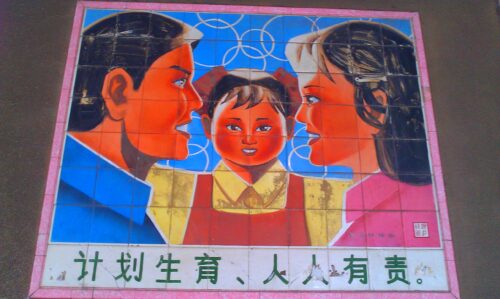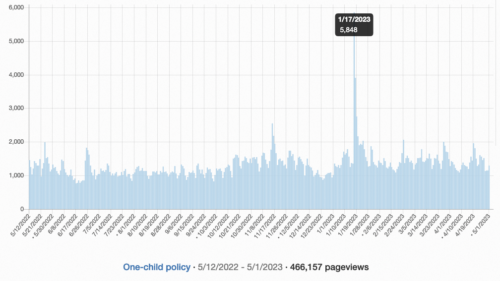Professor Yajun Mo’s course at Boston College delves into the changes in Chinese women’s lives through a period of profound change on the Chinese mainland: from the mid-19th century to the present. Yik Tung Tsui, a junior from Hong Kong majoring in history and mathematics, was one student in the course last year. He was shocked to learn that he and his peers would be writing Wikipedia articles as an assignment. Knowing his writing would be accessible to anyone on the internet made him nervous, but it was also a strong motivator.
“I feel that I have a responsibility to try my best to produce a comprehensible and precise piece of information about my topic so that I would not mislead anyone into receiving false information,” Yik Tung shares.
He chose to improve the article about mainland China’s one-child policy.

“One child policy in China was especially intriguing to me because the policy did not take effect in Hong Kong, but it left a footprint on the families of many of my peers and friends from mainland China,” Yik Tung says. “They had experienced the effect of the policy, and most of them are the only child in the family. Therefore, one-child policy is a very unfamiliar topic to me that drives my curiosity, and I wish to contribute to the English readers by incorporating information I extracted from some resources and materials that are in Chinese.”
Yik Tung made several improvements, including contextualizing the policy against the legacy of the Cultural Revolution, the international political landscape, newly developing social science fields within China at the time, the role of natural scientists in making policy decisions, and government restrictions on pursuing population-related scientific research. He also added information about the public’s response to the policies.
“I wish to add some more complexity to the reasoning behind the implementation of the one-child policy. The economic necessity to decrease new births in China was the most cited reason that people relied upon to justify the policy. But different perspectives also argue against this reason, and some scholars outside China offered their different views towards the policy. I hoped to include these realizations in the Wikipedia article. Evidence exists from arguments in support of and contrary to the necessity to limit childbirth. Therefore, I want to highlight the fact that the one-child policy is never a simple topic that can be accounted for by the very few words and information on Wikipedia. I hope my edits in the article will help readers to further understand the topic, and other knowledgeable people could also step in to improve the article as well.”
The beauty of writing for Wikipedia is that it allows for the very interdisciplinary approach Yik Tung took in representing one topic. Students can take the project in many directions, learning to look for gaps in the existing information about the topic and seek answers in peer-reviewed sources to fill them. As a multilingual student, Yik Tung brought the invaluable ability to draw from an even greater diversity of sources.
“Since I can also read Chinese, I have the chance to read the Chinese version of the one-child policy Wikipedia article. The article appears in much less in length, shows a different piece of information, and cites different sources. One example is that the Chinese version of the article was able to track the Chinese top leader’s decisions regarding the one-child policy during the period as such information was more approachable to Chinese scholars and sources. Such drastic differences between the information from different versions of the article remind me of the importance of perspectives. In this case, language is the main driver of the difference in perspectives.”
Yik Tung was able to help build the bridge between these different language versions, providing value on both sides. And he gained some important skills through the process.
“This Wikipedia assignment helped me to write articles in an informative and concise style. In my other academic works such as history essays, I always have an impulse to use flowery language, which sometimes sacrifices my ability to articulate my statement as I spent more time using complex words and phrases. I realize that precision in formulating and conveying ideas is more important. The writing process also forces me to constantly check my citations and avoid plagiarism. With numerous pieces of information at hand, it is very easy to plagiarize someone else’s work without knowing so. As a result, I spent more time making sure that I am citing and giving credit to others appropriately. Despite the huge amount of time I spent on this, I believe it is meaningful in the way that I now have a good habit of checking for plagiarism.”
Since he improved content, the article has been read more than 466K times by Wikipedia readers. And there was a noticeable upturn in readership this January when China announced its first population decline since the 1960s. Inadvertently, Yik Tung took part in this conversation by providing well-sourced context on one of the most trusted sources of online information out there.

Inviting students to write for Wikipedia as an assignment can provide great value to both the site and the classroom. Students make the assignment their own, finding inspiration in their topic and contributing to the encyclopedia in ways that draw upon their identities, areas of study, and personal interests. To learn more about incorporating a Wikipedia assignment into your course of any discipline, visit teach.wikiedu.org.
